The page is a list of Kirati kings who ruled in Nepal from c. 800 BCE to c. 300 CE. [1]
The page is a list of Kirati kings who ruled in Nepal from c. 800 BCE to c. 300 CE. [1]
According to a chronicle of Bansawali William Kirk Patrick [2] [3] and Daniel Wright, [4] The Kirat kings were:
| No. | Name | Dates | Reign Length | Succession | Notes |
|---|---|---|---|---|---|
| 1 | Yellung Hang or Yalambar | c. 800 BCE | 13 years | – |
|
| 2 | Pari Hang or Pabi | Son of Yalambar. | |||
| 3 | Skandhar Hang or Skhandhara | Son of Pabi. | |||
| 4 | Balamba Hang | Son of Skandhara. | |||
| 5 | Hriti Hang | Son of Balamba. | |||
| 6 | Humati Hang | Son of Hriti. | |||
| 7 | Jitedasti Hang | Son of Humati. |
| ||
| 8 | Galinja Hang or Gali | Son of Jitedasti. | |||
| 9 | Oysgja Hang or Pushka | Son of Gali. | |||
| 10 | Suyarma Hang | Son of Pushka. | |||
| 11 | Papa Hang or Parba | Son of Suyarma. | |||
| 12 | Bunka Hang | Son of Parba. | |||
| 13 | Swawnanda Hang | Son of Bunka. | |||
| 14 | Sthunko Hang | c. 250 BCE [5] | Son of Swananda. |
| |
| 15 | Jinghri Hang or Gighri | Son of Sthunko. | |||
| 16 | Nane Hang | Son of Gighri. | |||
| 17 | Luka Hang or Luk | Son of Nane. | |||
| 18 | Thor Hang | Son of Luk. | |||
| 19 | Thoko Han | Son of Thor. | |||
| 20 | Verma Hang or Barma | Son of Thoko. | |||
| 21 | Guja Hang | Son of Barma. | |||
| 22 | Pushkar Hang or Pushka | Son of Guja. | |||
| 23 | Keshu Hang or Kesu | Son of Pushka. | |||
| 24 | Suja Hang or Suga | Son of Kesu. | |||
| 25 | Sansa Han | Son of Suga. | |||
| 26 | Gunam Hang | Son of Sansa. | |||
| 27 | Khimbu Hang | Son of Gunam. | |||
| 28 | Paruka Hang or Patuka | Son of Khimbu. |
| ||
| 29 | Gasti Hang | Son of Patuka. |
| ||

Nepal is a multi-ethnic, multiracial, multicultural, multi-religious, and multilingual country. The most spoken language is Nepali followed by several other ethnic languages.
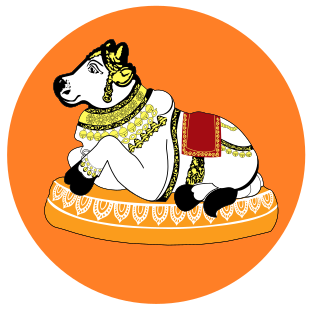
Bhairava, or Kala Bhairava, is a Shaivite and Vajrayāna deity worshipped by Hindus and Buddhists. In Shaivism, he is a powerful manifestation, or avatar, of Shiva. In the tradition of Kashmir Shaivism, Bhairava represents the Supreme Reality, synonymous to Para Brahman. Generally in Hinduism, Bhairava is also called Dandapani, as he holds a rod or danda to punish sinners, and Svaśva, meaning, "he whose vehicle is a dog". In Vajrayana Buddhism, he is considered a fierce emanation of boddhisatva Mañjuśrī, and also called Heruka, Vajrabhairava, Mahākāla and Yamantaka.

The Rai also known as Khambu and Jimee are ethnolinguistic group belonging to the Kirat family and primarily Tibeto-Burman linguistic ethnicity. They mainly reside in the eastern parts of Nepal, the Indian states of Sikkim, West Bengal and in southwestern Bhutan.

Newar, or Nepami, are primarily inhabitants in Kathmandu Valley of Nepal and the Indian territories of Sikkim state and Gorkhaland including its surrounding areas and the creators of its historic heritage and civilisation. The Newar are a distinct linguistic and cultural group, primarily Indo-Aryan and Tibeto-Burman ethnicities, who share a common language, Nepal Bhasa, and predominantly practice Newar Hinduism and Newar Buddhism. Newars have developed a division of labour and a sophisticated urban civilisation not seen elsewhere in the Himalayan foothills.

Yakkha or Dewan is an indigenous ethnic group from the Indian subcontinent, mainly in modern-day Nepal and present-day India. It is one of the descendants of Nepal's prehistoric Kirat dynasty. The Yakkha people are subsistence farmers who inhabit the lower Arun valley in eastern Nepal. They number only a few thousand and their language is nearly extinct.

The history of Sikkim begins with the indigenous Lepcha's contact with early Tibetan settlers. Historically, Sikkim was a sovereign Monarchical State in the eastern Himalayas. Later a protectorate of India followed by a merger with India and official recognition as a state of India. Lepchas were the main inhabitants as well as the Rulers of the land up to 1641. Lepchas are generally considered to be the first people, Indigenous to Sikkim also includes Darjeeling.
Ramgarh Raj was the major Zamindari estate in the era of the British Raj in the former Indian province of Bihar. Territories which comprised the Ramgarh Raj presently constitute districts of Ramgarh, Hazaribagh, Chatra, Giridih, Koderma, and Bokaro with 3672 villages. The entire area is rich in minerals like coal and mica and falls under the Indian State of Jharkhand. The First King was Maharaja Baghdeo Singh and the last ruling king was Maharaja Kamakhya Narain Singh of this estate, until the estate was merged to the Republic of India. The revenue of the estate was about 3600000.
Matrikas (Sanskrit: मातृका (singular), IAST: mātṝkā, lit. "mothers") also called Matar or Matri, are a group of mother goddesses who are always depicted together in Hinduism. The Matrikas are often depicted in a group of seven, the Saptamatrika(s) (Seven Mothers). However, they are also depicted as a group of eight, the Ashtamatrika(s). In the Brihat Samhita, Varahamihira says that "Mothers are to be made with cognizance of (different major Hindu) gods corresponding to their names." They are associated with these gods as their spouses or their energies (Shaktis). Brahmani emerged from Brahma, Vaishnavi from Vishnu, Maheshvari from Shiva, Indrani from Indra, Kaumari from Kartikeya, Varahi from Varaha and Chamunda from Chandi. and additionals are Narasimhi from Narasimha and Vinayaki from Ganesha.

The Kirati people, also spelled as Kirat or Kirant or Kiranti, are Sino-Tibetan ethnolinguistic groups living in the Himalayas, mostly the Eastern Himalaya extending eastward from Nepal to North East India.
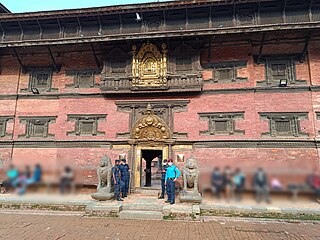
Patan Durbar Square is situated at the centre of the city of Lalitpur in Nepal. It is one of the three Durbar Squares in the Kathmandu Valley, all of which are UNESCO World Heritage Sites. One of its attractions is the medieval royal palace where the Malla Kings of Lalitpur resided.

Indra Jātrā, also known as Yenyā Punhi is the biggest religious street festival in Kathmandu, Nepal. "Ye" means the old Newari name for "Kathmandu", "Ya" means “Celebration”, and "Puhni" means full moon so together means the birthday of the old city of Kathmandu. The celebrations consist of two events, Indra Jātrā and Kumāri Jātrā. Indra Jātrā is marked by masked dances of deities and demons, displays of sacred images, and tableaus in honor of the deity Indra, the king of heaven. Kumāri Jātrā is the chariot procession of the living goddess Kumari.
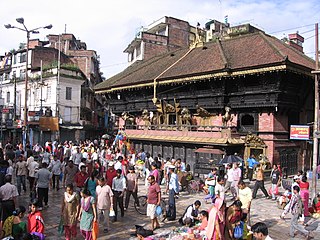
Indra Chowk or Wongha: (Newari) is one of the ceremonial and market squares on the artery passing through the historic section of Kathmandu, Nepal. The intersection of Indra Chowk, along with Maru, Kathmandu Durbar Square, Makhan, Jana Baha, Asan and Naxal, mark the old India-Tibet trade route that is now a vibrant market street.

Yalamber or Yalung, Yalambar, Yalamwar, Yalamver was a Kirati warrior and first king of the Kirata kingdom in Nepal, which he established in 800 B.C. His capital was Yalakhom, present day Kathmandu Valley (Thankot) after conquering Central Nepal and his kingdom extended from river Trishuli in the west to river Teesta in the east of Bhutan. Patan is also known as Lalitpur in Nepali and Yala in Newar in remembrance of Yalamber as he ruled the regions.

Vamshidhar Pande known by Alias Kalu Pande was a Nepalese politician and general who was appointed as Kaji of The Gorkha Kingdom. He was born in 1713 A.D. in a Gorkha family. He was the commander of the Gorkhali forces during the Unification Campaign of Nepal who died in the first Battle of Kirtipur in 1757 A.D. Pande's real name was Banshidhar Pande. He was a son of Kaji Bhimraj Pande who was minister during reign of King Prithivipati Shah of Gorkha. He was descendant of Minister of Gorkha and Dravya Shah's accomplice Ganesh Pande. He had three sons: Dewan Kajisaheb Vamsharaj Pande, Sardar Ranasur Pande and Mulkaji Sahib Damodar Pande.

The Kirat Region is an area of the Eastern Himalayas which is inhabited by ethnic Kirati people. in the History of Nepal earliest inhabitants of Nepal are Kiratis of Eastern hills.Kirati states divided into three subdivision "Wallo Kirat” or Near Kirat is from east of Kathmandu Valley to Likhu Khola, "Majh Kirat” or Middle Kirat is east of Likhu River to Arun River and the "Pallo Kirat” Limbuwan or Far Kirat is east of Arun River to Mechi River.
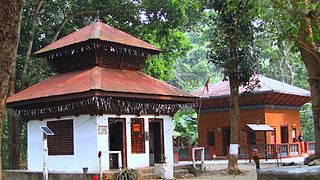
Valmiki Ashram is a Hindu Balmiki temple situated in Chitwan district of Nepal, inside Chitwan National Park. It is close to the Triveni Dham where Tamasa, Sona and Sapta Gandaki rivers meet. Deities worshipped here include Rama, Sita, and Valmiki. The festival of Rama Navami is also celebrated here.

The Mahisapala Dynasty was a dynasty established by an Abhira that ruled the Kathmandu Valley. They were also known as Mahispalbanshi. They took control of Nepal after replacing the Gopala dynasty. The Gopalas and the Mahisapalas were together known as Abhiras. Three kings of Mahisapala dynasty ruled the valley before they were overthrown by the Kiratas.
The earliest inhabitants of modern Nepal and adjoining areas are believed to be Australoid people. By 4000 BCE, the Tibeto-Burmese people had reached Nepal either directly across the Himalayas from Tibet or via Myanmar and north-east India or both. By the late Vedic period, Nepal was being mentioned in various Hindu texts, such as the late Vedic Atharvaveda Pariśiṣṭa and in the post-Vedic Atharvashirsha Upanishad. The Gopal Bansa was the oldest dynasty to be mentioned in various texts as the earliest rulers of the central Himalayan kingdom known by the name 'Nepal'. The Gopalas were followed by Kiratas who ruled for over 16 centuries by some accounts. According to the Mahabharata, the then Kirata king went to take part in the Battle of Kurukshetra. In the south-eastern region, Janakpurdham was the capital of the prosperous kingdom of Videha or Mithila, that extended down to the Ganges, and home to King Janaka and his daughter, Sita.
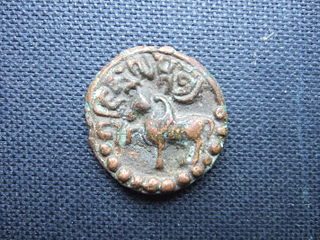
The Abhira-Gupta dynasty also known as the Ahir-Gupta dynasty was a dynasty which existed in the Kathmandu Valley in modern-day Nepal. These Abhira-Guptas had overshadowed the Licchavi kings in the administration. Ravigupta, Bhaumagupta, Jishnugupta and Vishnugupta of Abhira-Gupta family controlled Kathmandu (Nepal) as de facto-ruler during many Lichchhavi kings.
{{cite book}}: CS1 maint: location missing publisher (link)